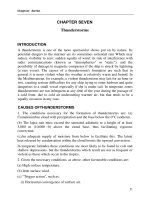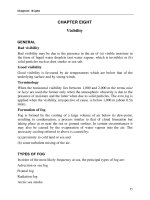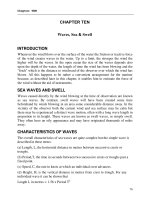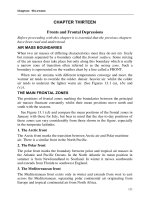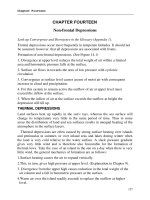BÀI GIẢNG KHÍ TƯỢNG LÝ THUYẾT CHƯƠNG 18
Bạn đang xem bản rút gọn của tài liệu. Xem và tải ngay bản đầy đủ của tài liệu tại đây (92.91 KB, 9 trang )
Chapter Eighteen
CHAPTER EIGHTEEN
Weather Forecasting for the Seaman
PART I - WEATHER FORECASTING
The term forecast was coined in its meteorological sense by Admiral Fitzroy
when he first attempted to anticipate the weather and to issue visual storm
warnings in about '1860. It was a wise and prudent choice of a word, for even
today with the wide network of observations, speedy communications and long
experience, aided by the high speed computer and satellite pictures, the weather
forecaster can only attain reasonable accuracy at about 24 hours ahead. Owing
to the frequency at which forecasts are broadcast this modest attainment is of
enormous value for the safety and economy of shipping and it is fortunate for
the mariner that wind, the most significant parameter, is not a very difficult one
to forecast.
THE SYNOPTIC MAP
The basic tool of the weather forecaster is and always has been the synoptic
map, which gives him a synopsis or birds-eye view of the factors which make
up the existing weather over as wide an area as possible and this implies good
communications in particular.
Before Marconi came on the scene only the electric telegraph was available,
so the network was limited to land areas. The introduction of wireless
telegraphy in 1901 enabled weather reports to be received from ships at sea.
The structure of the modern surface weather map goes back to the first world
war when the frontal theory of meteorology was generally accepted.
The international network of upper air observations of pressure, humidity,
temperature and wind, to a height of about 10,000 metres, enabling upper air
maps to be prepared, was started soon after the second world war. Now we
have observations of cloud cover, extent of sea ice, etc, from weather satellites
and we also have the high speed computer, all of which are of great help to the
meteorologist in his attempt to attain accurate forecasts.
PREPARATION
All synoptic weather observations are transmitted in a simple international
code which transcends all language barriers, and the method of preparing the
resultant map is also international; thus a Russian or a Chinese can readily
157
Chapter Eighteen
understand a British synoptic map and vice versa. In fact there is a regular
exchange by radio facsimile of up-to-date weather maps. The observations forming
the basis of the four main synoptic maps each day are made on a rigid time
schedule: 0000, 0600, 1200 and 1800 GMT. Many hundreds of observations are
thus received regularly by the relevant meteorological services in each region and
are then re-transmitted for the benefit of all those requiring them, the observations
having been provided from a fixed network of shore stations, from ships at sea and
from aircraft in flight. plus the upper air observations from a much more widely
spaced network.
Observations are fed into a computer model of the atmosphere and this produces
both analysis and forecast charts.
PART II - SPECIAL METEOROLOGICAL SERVICES FOR
SHIPPING
Because international meteorology was born out of the Maritime Conference at
Brussels in 1853 and since then most of the oceans' weather observations have
come from merchant ships. it is not surprising then that Meteorological Services
have for many years done their best to help shipping by providing forecasts and
essential climatological information. Nowadays almost all ocean and coastal areas
are covered by radio weather bulletins of one kind or another.
The earliest information available for shipping was solely climatological plus
ocean current maps compiled from the data in ships' log books. This was
transformed by the advent of wireless telegraphy in the twentieth century which
now meant that ships could transmit weather observations to shore and the
converse. that weather bulletins could be broadcast to shipping for specific ocean
areas. Both World Wars heightened the importance of meterological information
for military purposes and the first bulletins were issued from 1919 onwards. these
relating to the North Atlantic. Since 1948 each Meteorological service with a
seaboard is responsible for the issue of standard bulletins covering designated and
published areas.
STORM WARNINGS
Until recently Fitzroy's visual storm warnings consisting of the North or South
cone for winds with a Northerly or Southerly component respectively were still
exhibited at the few remaining coastguard stations and at a few ports, when winds
of Force 8 and above were expected. In June 1984 they were discontinued because
it is considered almost certain that all vessels likely to proceed offshore nowadays
are fitted with radio and are able to receive the relatively frequent and
comprehensive forecasts and warnings with which modern seamen are so familiar.
158
Chapter Eighteen
More elaborate visual signals are exhibited in certain countries, for example the
United States and the typhoon warnings in Hong Kong.
Under the WMO scheme, every radio weather bulletin for shipping, whether it
be for ocean areas or coastal waters, includes warnings of Gales (Force 8 and
above) and Storms (Force 10 and above) when either of these is anticipated. In
tropical areas, during the cyclonic storm season, special steps are taken to give very
early warning of the approach and development of such storms; if the warnings are
transmitted at unscheduled times they are repeated in the routine bulletins.
RADIO BULLETINS FOR SHIPPING
The map in Figure 18.1 shows that under an international scheme prepared by the
WMO practically all ocean areas are today covered by radio weather bulletins for
shipping on the high seas; they are broadcast by W/T every 12 hours at least. The
bulletins are presented in a more or less standard form so that they are readily
understood, the text being in the language of the issuing country and English. In a
few cases a simple code may be used. The contents of these bulletins are in
compliance with the International Convention for Safety at Sea in association with
the WMO and they are designed to give the maximum of essential information as
briefly as possible. In some cases more than one nation issues bulletins for the
same area; this is not necessarily a handicap if more than one bulletin gives a
sin1ilar forecast the mariner can have more confidence in it. Bulletins for coastal
areas are commonly broadcast by R/T or on domestic broadcast - often at fairly
frequent intervals and their contents are often somewhat briefer. Details of all
bulletins for shipping are given in the Admiralty list of Radio Signals, Vol. 3.
FORECASTS
Every radio bulletin for shipping, whether it be for ocean or coastal areas contains,
in addition to gale and storm warnings, a forecast of the expected wind, weather
and visibility for the next 24 hours, for the various sections of the area concerned.
In some areas (e.g. off Iceland and in the Baltic) warning of sub-freezing air
temperature is given. Usually the forecast is preceded by a brief statement of the
existing weather systems in the area and their expected movement and
development.
DETAILS OFTHEWEATHER BULLETIN REGIONS
Many of the larger ocean areas shown on Figure 18.1 are subdivided into sections
to facilitate descriptions of the actual and forecast weather. For example, the UK
authorities divide the Eastern Atlantic outside coastal areas into six standard
sections. Coastal areas are not delineated on this map.
159
Chapter Eighteen
ACTUAL WEATHER REPORTS
Most bulletins for the high seas and some for coastal areas contain reports of
existing weather conditions at a selection of ships and/or shore stations. These
reports include wind direction and force. weather, visibility. barometric pressure
and. sometimes. wave data from the ships. These data are included to give the
mariner an overall picture of the situation in as wide an area as practicable.
THE USE OF RADIO FACSIMILE ABOARD SHIP
Radio facsimile maps are broadcast by several Meteorological Services and the
frequencies used are such that they can be received aboard any ship with a suitable
receiver. Some FAX machines can be set for "automatic" reception. The machine
is then switched on and off by a pulse received at the beginning and end of the
chart transmission. Details of the charts available and transmission schedules can
be obtained from the Admiralty List of Radio Signals, Volume 3. A wide selection
of weather maps is available by radio FAX. Analysis charts are produced every six
hours and prognostic charts are available for 24, 48 and 72 hours. Times and types
of charts available depend upon the transmitting stations. Charts can be received
which detail sea surface temperature. the extent and type of sea ice and the position
and strength of surface currents. These charts, together with charts detailing sea
and swell heights. can be used for route planning.
SPECIAL ADVICE ON REQUEST
Most Meteorological Services are willing to give special advice about impending
weather in a particular area on request. by phone or radio.
CLIMATOLOGICAL INFORMATION
Much information about climatic conditions in various parts of the world's ocean
and coastal waters is given in the Admiralty Pilots. This has been largely compiled
from data shown in climatic atlases prepared by Meteorological Services from
observations made aboard merchant ships.
INTERNATIONAL ASPECTS OF METEOROLOGY
The weather recognises no frontiers. Every country needs as accurate information
as possible about the present and future weather, not only for the safety of all forms
of transport and for a variety of industrial and economic purposes, but for
agriculture, sport and tourism. This involves the rapid receipt of regular
observations from numerous locations in various countries and oceanic areas. It is
not surprising therefore that international cooperation in the science of meteorology
has a long and outstanding history of success.
160
Chapter Eighteen
161
Chapter Eighteen
METEOROLOGICAL ORGANISATIONS
It was a seaman, Lieut . Maury of the US Navy, who took the initiative when he
inspired and organised the first International Conference on Maritime Meteorology
at Brussels in 1853. It seems quite natural that international meteorology should
have this maritime origin because weather directly affects the safety, comfort and
prosperity of the mariner more than almost anybody else. In 1855, as a result of the
Brussels Conference. the British Meteorological Office was born, its first Director
being another seaman, Admiral Fitzroy-its function being to collect the
observations from ships at sea for compiling meteorological atlases and to collect
data about surface currents of the oceans and other phenomena for the benefit of
shipping. Under Fitzroy's direction a visual storm warning service for shipping was
started and a rudimentary forecast service. In 18i3, resulting from an international
conference at Leipzig, at which the Directors of most of the then meteorological
services were present, the International Meteorological Organisation (1MO) was
founded. This was a more or less unofficial body, its function being to co-ordinate
all meteorological activities on a worldwide basis and it proved very successful. In
1951 the IMO was transformed into the World Organisation (WMO) , an official
inter-governmental body and specialised agency of the United Nations; about 178
countries are members at present (1995).
FUNCTIONS AND STRUCTURES OFTHEWMO
The main purposes of the ~10 are to arrange, internationally:
a) networks of observing stations and the requisite communication facilities.
b) standardisation of observing practice and meteorological codes and publication
of statistics.
c) The most effective application of meteorology to shipping, aviation, agriculture
and other human activities.
d) The encouragement of research and training.
To carry out its work the WMO has a Secretary General and headquarters staff at
Geneva under the direction of an Executive Committee of 24 Directors which
meets annually. The supreme body is the ~10 Congress which meets once every
four years. For operational purposes the world is divided into six regions, in each
of which the meteorological activity is coordinated by a regional association. The
technical work of WMO is done by eight Technical Commissions, composed of
experts appointed by individual countries; they have four-yearly meetings and do
their work between sessions by correspondence. The Commission for Maritime
Meteorology, which is in effect the offspring of the 1853 Brussels Conference,
looks after all aspects of Maritime Meteorology.
162
Chapter Eighteen
INTERNATIONAL METEOROLOGY IN ACTION
Today every country in the world has a sizeable network of meteorological
observing stations. a few of which make upper air observations by radio controlled
instruments carried aloft by balloon to a height of about 18,000 metres (60,000
feet). Observations are made at regular intervals and the coded results are
immediately transmitted by the quickest means to a national collecting centre,
where they are immediately plotted on synoptic weather maps and used for
forecasting purposes. At the same time these messages are re-transmitted to other
countries and to regional collecting centres whence they are transmitted again for
the benefit of countries in other regions. Thus, for example the United Kingdom
has the benefit of observations as far away as the Pacific coast of the USA. The
codes, maps and plotting procedure are such that a meteorologist of any nationality
can readily understand them without interpretation. Today the weather maps
prepared in most countries are broadcast in detail by radio-facsimile for the benefit
of other countries. Also all countries can easily have available regular images of
world-wide meteorological observations (cloud cover, etc.) made by satellite.
THE SELECTED SHIP SCHEME
The oceans not only occupy three-quarters of the Earth's surface but are the main
source of atmospheric disturbances and of our varied weather generally. Hence the
meteorologist has a vital need of regular observations from ocean areas.
The selected ship scheme is international and is run under the auspices of the
WMO. Observations are made by the appropriate watchkeeper every six hours
covering barometric pressure, air and sea temperatures, direction and strength of
wind, wave heights, current weather, cloud cover and visibility. This information is
then coded numerically and is transmitted to designated shore radio stations.
Summarised information about making the observations and about the
instruments used is given in Chapter 25. Details are given in "The Marine
Observer's Handbook:' which is issued free to all British Selected Ships and
can be bought from HM Stationery Office. By taking part in this scheme
masters can feel that they are providing much-needed help to the meteorologist
in his job of providing forecasts for ocean areas.
Most Selected Ships make and record in their meteorological logbook ocean
current observations and observations of various meteorological,
oceanographical and ornithological phenomena which they encounter. At the
end of the voyage the logbook is collected from the ship by the Port
Meteorological Oft1cer and sent to his headquarters office where all the
meteorological data are extracted and used for climatological purposes, as was
done when the Selected Ship scheme started in 1853.
163
Chapter Eighteen
WEATHER SATELLITES
There are two main types of weather satellites - geostationary and polarorbiting
satellites. Geostationary satellites are placed in orbit abO\"e the equator at a
height of approximately 36,000 kilometres, the period of their orbit results in
the satellite remaining stationary over the same point on the earth surface. Polar
orbiters are in rather lower orbit and they circle the earth at a height of
approximately 850 kilometres.
The satellites provide images in both the visible and infra red parts of the
spectrum. The visible images are dependent upon sunlight reflected from the
earth's surface and are therefore not available at night. Visible images of higher
latitudes in the "winter" hemisphere are often very poor. The infra-red images
are always available since they depend. not on sunlight, but upon the radiation
emitted by the earth and its atmosphere.
The satellites also carry equipment sensors to provide other information. This
information includes measurement of sea state, water vapour images and
temperature profiles.
Information from visible and infra red images can be combined to provide
information on cloud height and type, based upon the cloud texture and
temperature. The images can also be used to assess the positions of fronts.
GLOBAL WARMING
Observations of surface weather conditions also have an important role in
research into the earth's climate. Over the last two decades there has been an
increase in public concern about climatic change. It is well established that the
quantity of carbon dioxide in the earth's atmosphere has been steadily
increasing, because this is a major end product when fossil fuels, such as coal,
wood and oils, are burnt. Carbon dioxide is an important atmospheric gas because
it is relatively transparent to short wave radiation from the sun but absorbs long
wave radiation from the earth and clouds. An increase in carbon dioxide should
raise the mean temperature of the earth because it prevents some of the out-going
radiation from leaving.
Identifying the effects of global warming is not simple since the earth's climate is
not constant. Over long periods of time, changes are known to occur due to the
changing parameters of the earth's orbit and the tilt of the earth's axis. Major
volcanic eruptions can put large quantities of volcanic dust into the atmosphere. the
presence of this dust is associated with a cooling of the earth’s surface. Because of
the difficulties in distinguishing the effects of global warming from the natural
variability of the climate and predicting the likely consequences of global warming,
the United Nations Intergovernmental Panel on Climatic Change (IPCC) was
164
Chapter Eighteen
established in 1988 to advise world leaders on the seriousness of global climate
change.
Computer models of the atmosphere have been used in order to try to predict the
effects of increased carbon dioxide. The results of these models vary but all agree
that a global rise in mean temperature of about 1.5 °c to 4.5°C is probable from a
doubling of carbon dioxide. The differences are due to the way in which the models
deal with factors such as clouds and atmospheric moisture. There are many
possible feedback mechanisms. Melting of ice due to global warming would cause
less solar radiation to be reflected and so would increase global warming. A rise in
temperature would cause more evaporation from the ocean and since water vapour
is a greenhouse gas this would increase warming. By contrast, an increase in
cloudiness would increase the amount of incoming solar radiation reflected back to
space and thus would reduce the warming.
Practically, the effect of such a rise in temperature would not result in a rise of
mean temperature at every place on the earth at all seasons, changes would be
likely in the general pattern of weather systems and there would be regional and
seasonal variations. Changes in the pattern of rainfall and the general weather
would have important effects on agriculture and food production. The rise in sea
level would have important implications for coastal communities.
QUESTIONS
1. State what you know about the international scheme for the issue by radio of
storm warnings, forecasts and general weather bulletins for shipping.
2. What is the value to the seaman of giving details of existing weather in
ocean areas in addition to a forecast for the same area?
3. Where do you find details about weather information for shipping broadcast
by radio?
4. State what you know about radio facsimile apparatus, the meteorological
information that it transmits and its value to the shipmaster.
5 Describe the operation of NAVTEX.
165

